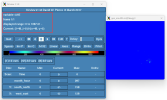1. To completely disable AHE in WRF-SLUCM, you can put distributed_ahe_opt = 0 and manually turn off AHE in the urban parameter table (both AHOPTION: 0 and ALHOPTION: 0).
2. As I answered to your question in another forum thread, to use your own grid-based AHE data:
(1) The "distributed_ahe_opt" namelist option controls a specific AHE data that has been implemented into WPS. If you want to use this option to read in your own data, you could use your own AHE data/map to replace the one generated by default WPS in geo_em file.
(2) The "distributed_ahe_opt" overlaps with the AHE specified from the urban parameter table, so if you use the "distributed_ahe_opt" option, please make sure you turn off the AHE in the urban parameter table for your simulation.
(3) The "distributed_ahe_opt" directly adds the AHE to the temperature tendency or surface sensible heat flux after the land and urban model processes are done (i.e., outside urban code), while the AHE specified in urban parameter table adds AHE to the urban flux within the urban code. This is the key difference.
Here is the main code changes related to "distributed_ahe_opt" capabilities:
[Resubmit for PR #1881] New option for SLUCM to use global distribute… · wrf-model/WRF@3cadf04
3. To use "grid-based AHE is used for vehicle emissions, while URBPARM.TBL is used for other heat sources like buildings", you can develop a AHE grid dataset for vehicle emission as input and set distributed_ahe_opt >0, and at the same time activate AHE in the urban parameter table and modify the value to match with other heat sources. To confirm if you are doing it correctly, you can do two test experiments by turning off one of the AHE sources and see the surface temperature difference and surface sensible heat flux difference in your output.

